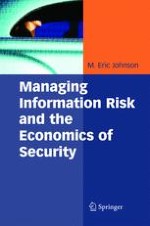2009 | OriginalPaper | Buchkapitel
10. The Impact of Incentives on Notice and Take-down
verfasst von : Tyler Moore, Richard Clayton
Erschienen in: Managing Information Risk and the Economics of Security
Verlag: Springer US
Aktivieren Sie unsere intelligente Suche, um passende Fachinhalte oder Patente zu finden.
Wählen Sie Textabschnitte aus um mit Künstlicher Intelligenz passenden Patente zu finden. powered by
Markieren Sie Textabschnitte, um KI-gestützt weitere passende Inhalte zu finden. powered by
